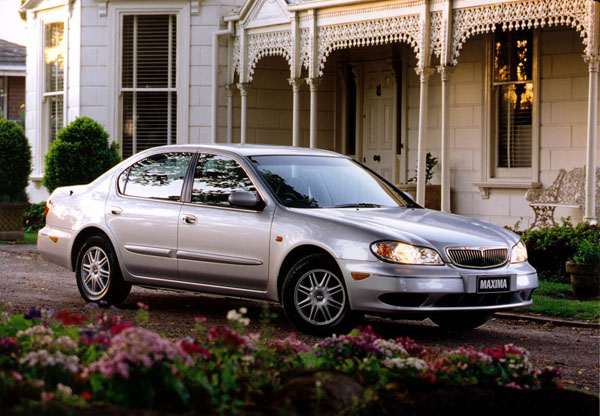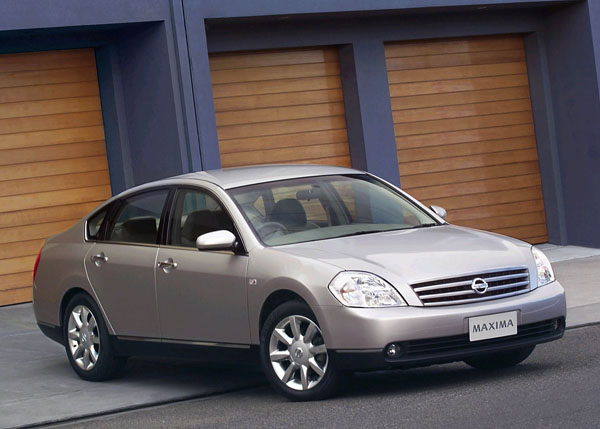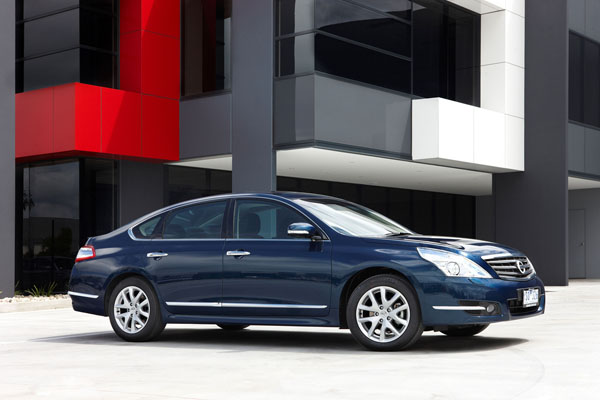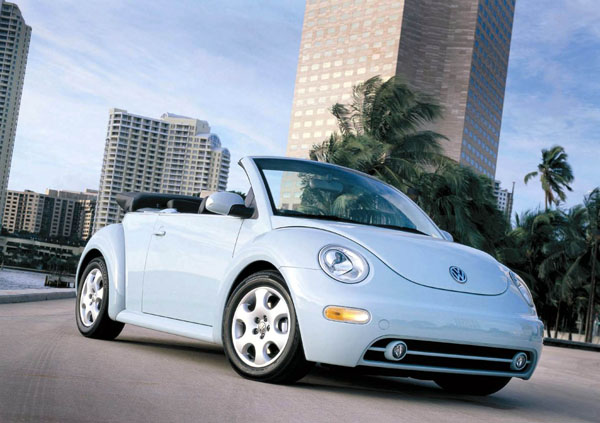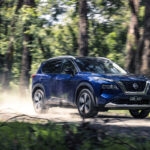For some unknown reason the Nissan Maxima is too often overlooked in the family car market, both by buyers of used and new cars. It deserves a place on your shopping list because it’s about the same size as the Toyota Aurion and isn’t a lot smaller than Commodore and Falcon.
All three of these competitors are built in Australia and even the Toyota has a lot of Aussie engineering in its makeup. Perhaps that’s one reason Maxima does fare as well as it should.
Handling is softer and less responsive than that of the local sixes, but the Nissan is safe and predictable and will suit all but sports sedan enthusiasts.
Maxima’s ride on smooth surfaces is quiet and comfortable. However, it’s not quite as good on really rough corrugations and course-chip surfaces as cars that are specifically built for Australian roads. If yours is to be used in the city and suburbs you will find it refined and pleasant to live with.
The big Nissan can carry five adults will fit if they don’t mind some shoulder rubbing, Mum, Dad and three kids works well.
Styling of the Maxima was somewhat unusual in the pre-1995 models but then went mainstream for a few years. Then, from late 2003 it took a radical route in its shape. The 2009 model went back onto the conservative track. Take your pick…
The latest Nissan Maxima, made from September 2014, is no longer built in right-hand drive, so Australian imports have ceased.
Maximas prior to the 2003 model, use a single-camshaft 3.0-litre V6 engine. From 1995, a twin-cam 3.0 was installed. While the older engine wasn’t bad, the newer unit has plenty of low-down torque and immediate throttle response. So it really appeals to drivers of cars set up in the Australian fashion. The twin-cam engine is also noticeably smoother and quieter than the old single-cam one. The 2003 Maxima received an excellent 3.5-litre V6 and it’s better still.
In 2009, Nissan Australia made an interesting move in introducing of a small 2.5-litre V6 as an option to the 3.5-litre unit. The smaller engine has more performance than you might expect, but traditionally buyers of six-cylinder family cars in Australia want plenty of grunt and the 2.5 may disappoint them. The smaller engine uses less fuel – unless you thrash it to get the performance of the larger unit.
Nissan Maxima is unusual in having a manual transmission option in a market that’s normally automatic-only. it was only offered during 1995 and 1996 and only in the lower-cost model. It could be difficult to resell. Then again, if you are doing a lot of country driving where few gear changes are required, a manual will save on fuel.
The automatic transmission had four forward ratios until becoming one of the early adopters of a continuously variable transmission (CVT) in 2006. The CVT gives a little more performance and there’s some reduction in fuel consumption. Some drivers may initially not like CVT’s the different sound and feel. It’s an acquired taste so give it a good long road test if you haven’t experienced a CVT before.
Maxima model names have a somewhat confusing history. The lower-priced versions, called Maxima M in the pre-1995 models, Maxima 30J until October 1996, Maxima 30S Touring, and currently Maxima S. For their day they were well-equipped, with air conditioning, alloy wheels, power windows, cruise control and a quality stereo.
The topline cars, tagged Maxima Ti then Maxima 30GV, then back to Maxima Ti again, are loaded with gear, with power-operated front seats, leather trim (not used in all early Ti models) and ABS brakes. Additionally the 30GV and later Ti variants have climate-controlled air conditioning, a power sunroof, dual airbags, a built-in alarm system and foglights.
From 2003, the lower-cost model became the ST-L, with the Ti tag being retained by the upper-crust variants, a further upgrade to the Ti is called the Ti-L and is loaded with good gear.
Spare parts prices are often a little higher than average for this class, reflecting the fact that the Maxima is fully imported. We hear very few complaints about prices so owners presumably consider them acceptable.
The good home mechanic can do some of their own maintenance and minor repair work on older models, later ones are pretty complex in places. Underbonnet access is good but make sure you have a workshop manual before diving in too deep.
The Australian Nissan dealer network is long established and works well with outlets in virtually every area, even those deep in the outback. The latter may not always keep spare parts on hand for the Maxima so you may face a wait if unlucky enough to have problems in the bush.
Insurance charges, though sometimes higher than for Commodores and Falcons, aren’t usually excessive. There can be a bigger than average range of premium charges so it’s smart to take time to shop around; make sure you’re doing an accurate comparison between companies.
Always have a professional do a final inspection as these are relatively complex cars and it’s easy to miss some items.
WHAT TO LOOK FOR
Look for body damage or repairs following a crash, an inspection of the front tyres for uneven wear and a look over the seats, door trim and carpets for signs of rough use.
The engine should start almost the moment you turn the key and idle smoothly and quietly immediately.
A smoking exhaust is probably a sign of expensive wear so should be treated with extreme caution.
If the automatic transmission is slow to go into gear or rough in its changes it could be due for an overhaul, but it may just be due for a routine service.
Check the brakes pull up the car in a straight line and that one wheel doesn’t lock before the others. If ABS is installed you should feel a pulsing through the pedal during hard braking. If it’s too harsh have a mechanic check it out.
Make sure there are no suspension noises when the car is driven on rough roads. This could indicate the car has had a hard life bouncing around in the bush.
HOW MUCH?
Expect to pay from $3000 to $6000 for a 2000 Nissan Maxima Ti; $6000 to $10,000 for a 2005 Ti-L; $10,000 to $15,000 for a 2009 350 ST-S; $12,000 to $17,000 for a 2012 250 ST-L; $17,000 to $24,000 for a 2012 350 Ti; $20,000 to $28,000 for aa 2013 350 Ti; and $23,000 to $32,000 for a 2014 350 Ti.
CAR BUYING TIP
People who own something unusual in cars often seem to take extra pride in them, driving carefully and having them serviced right on schedule.




